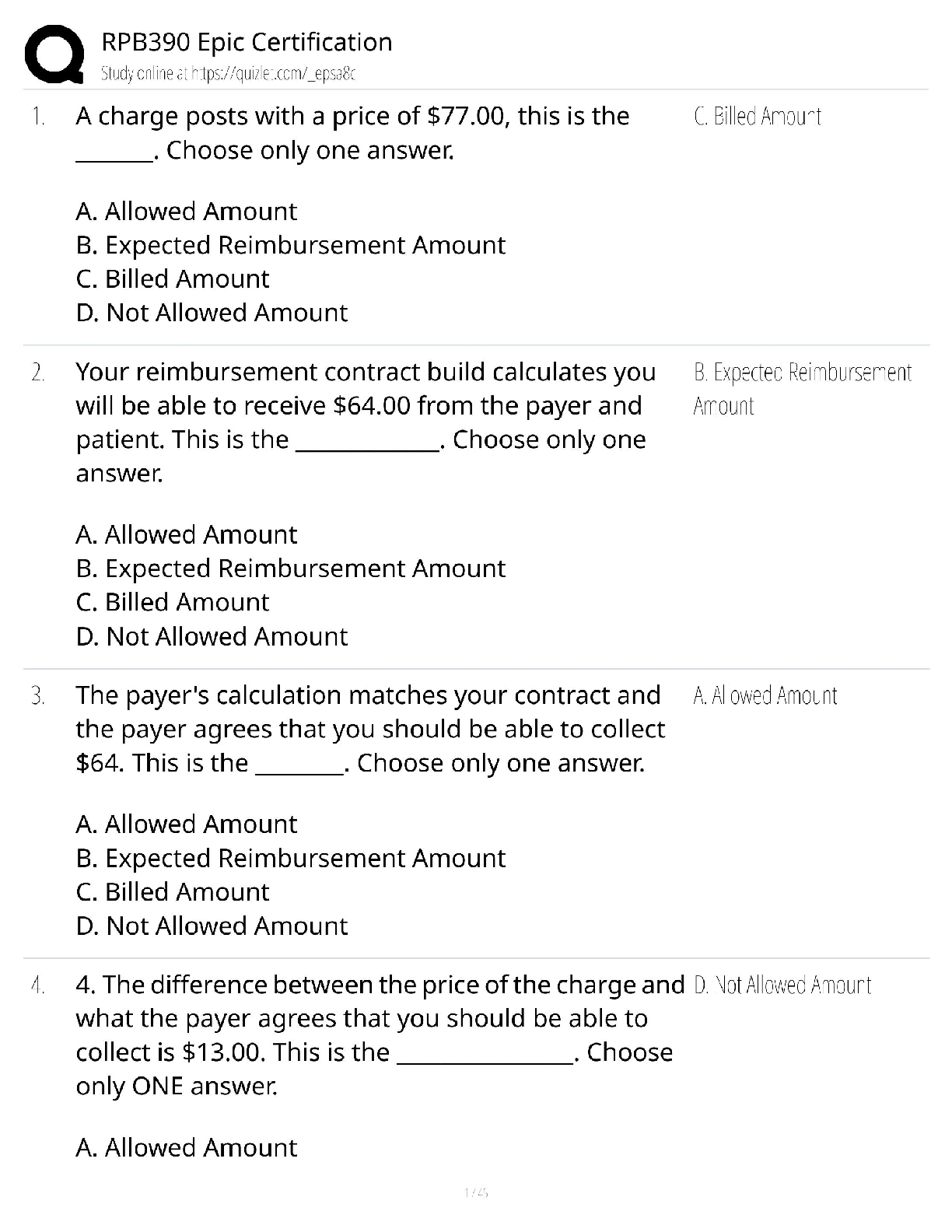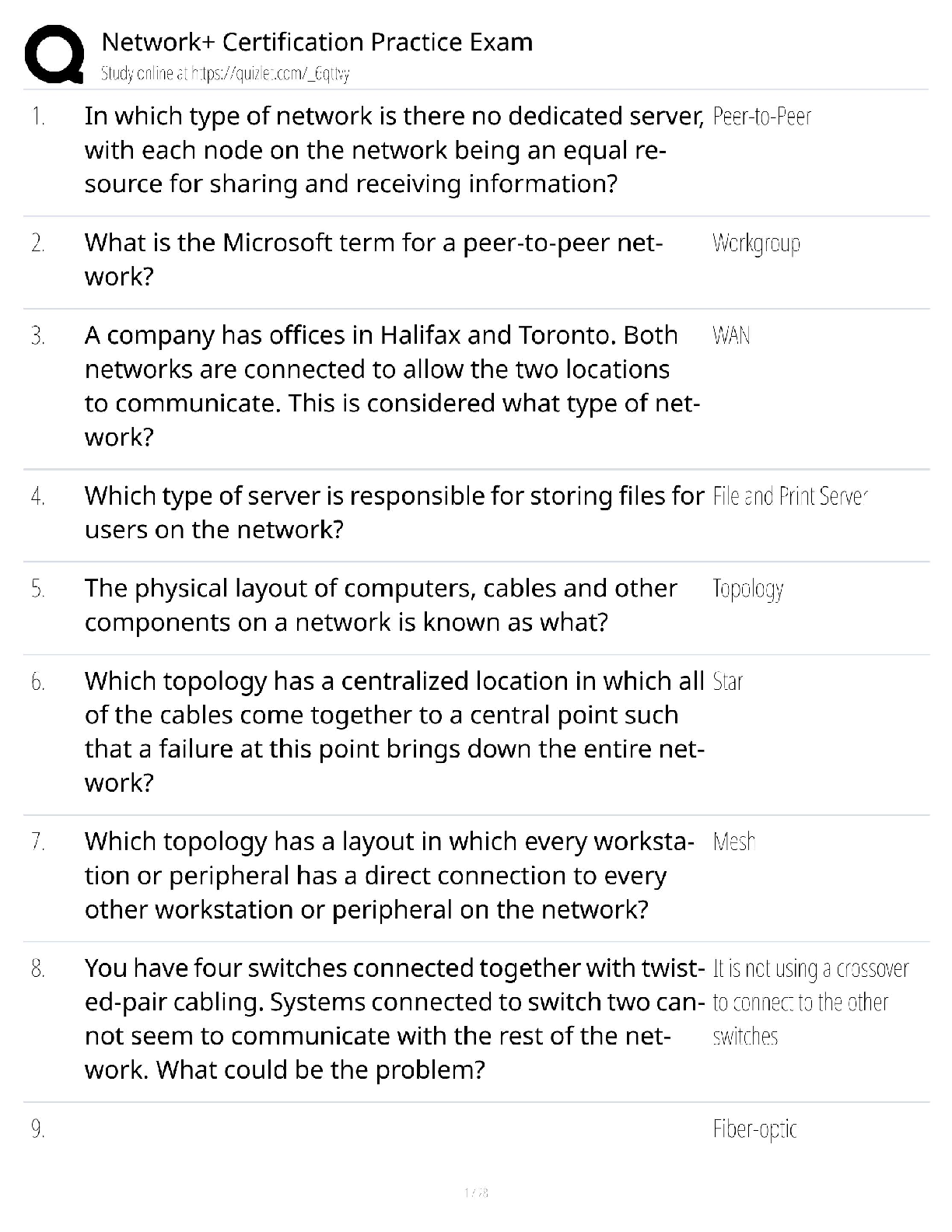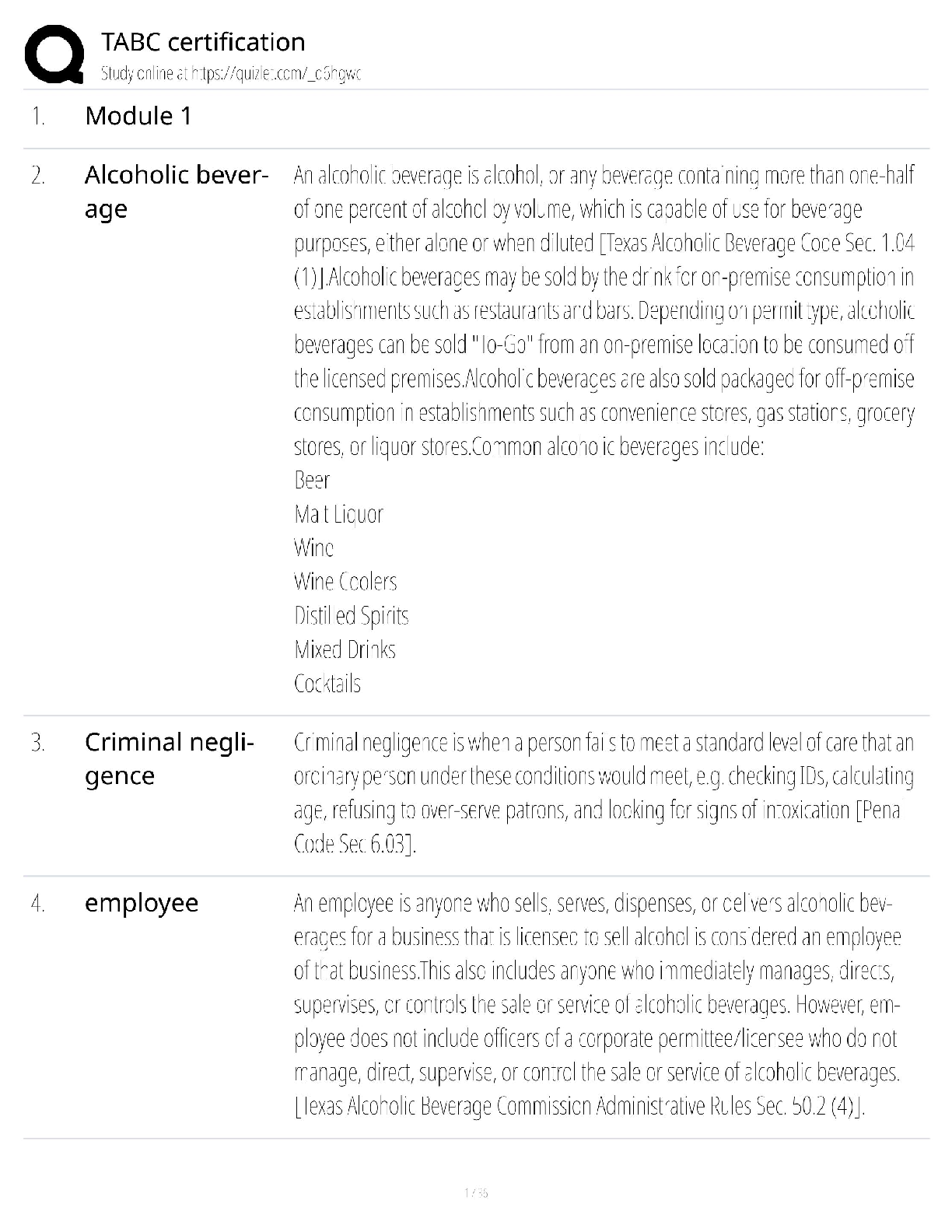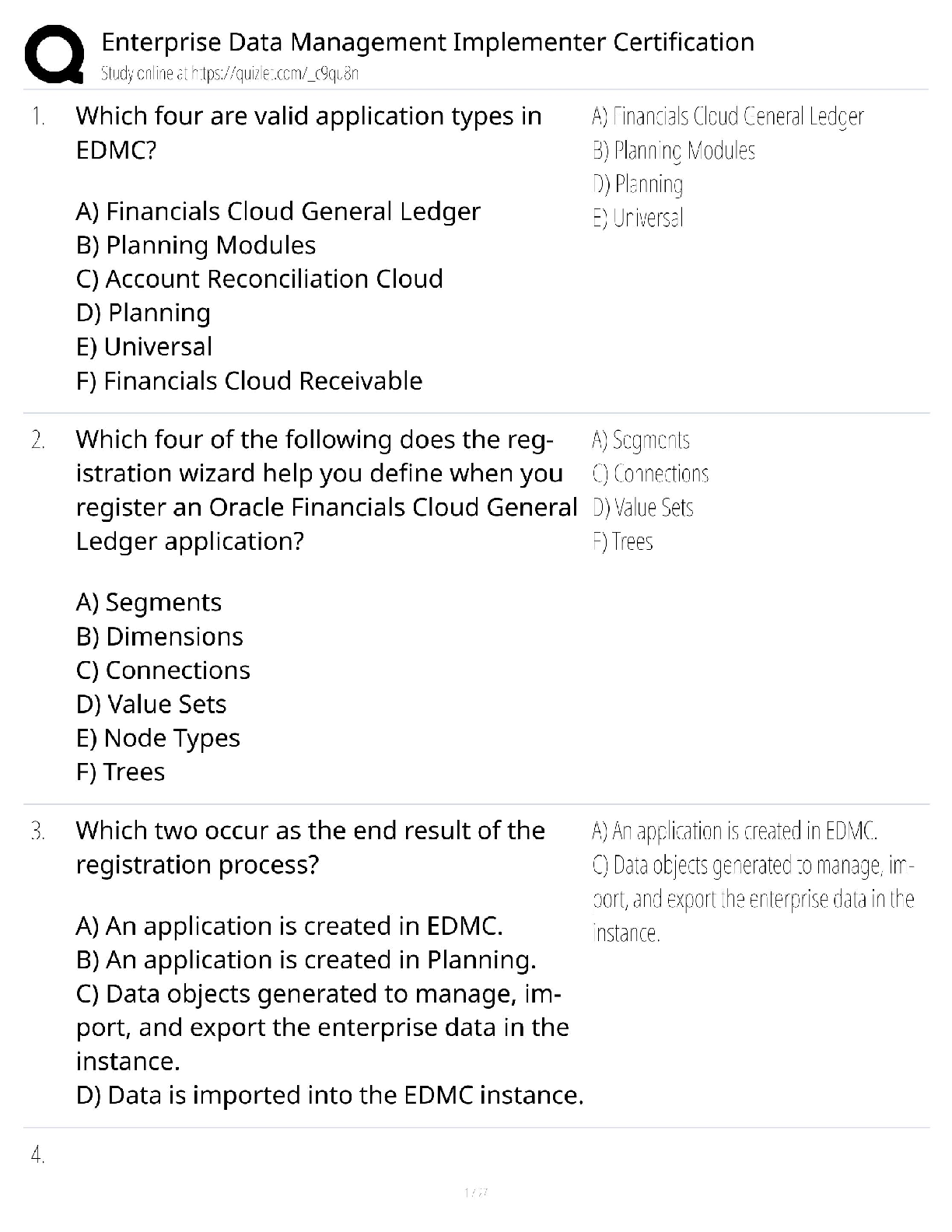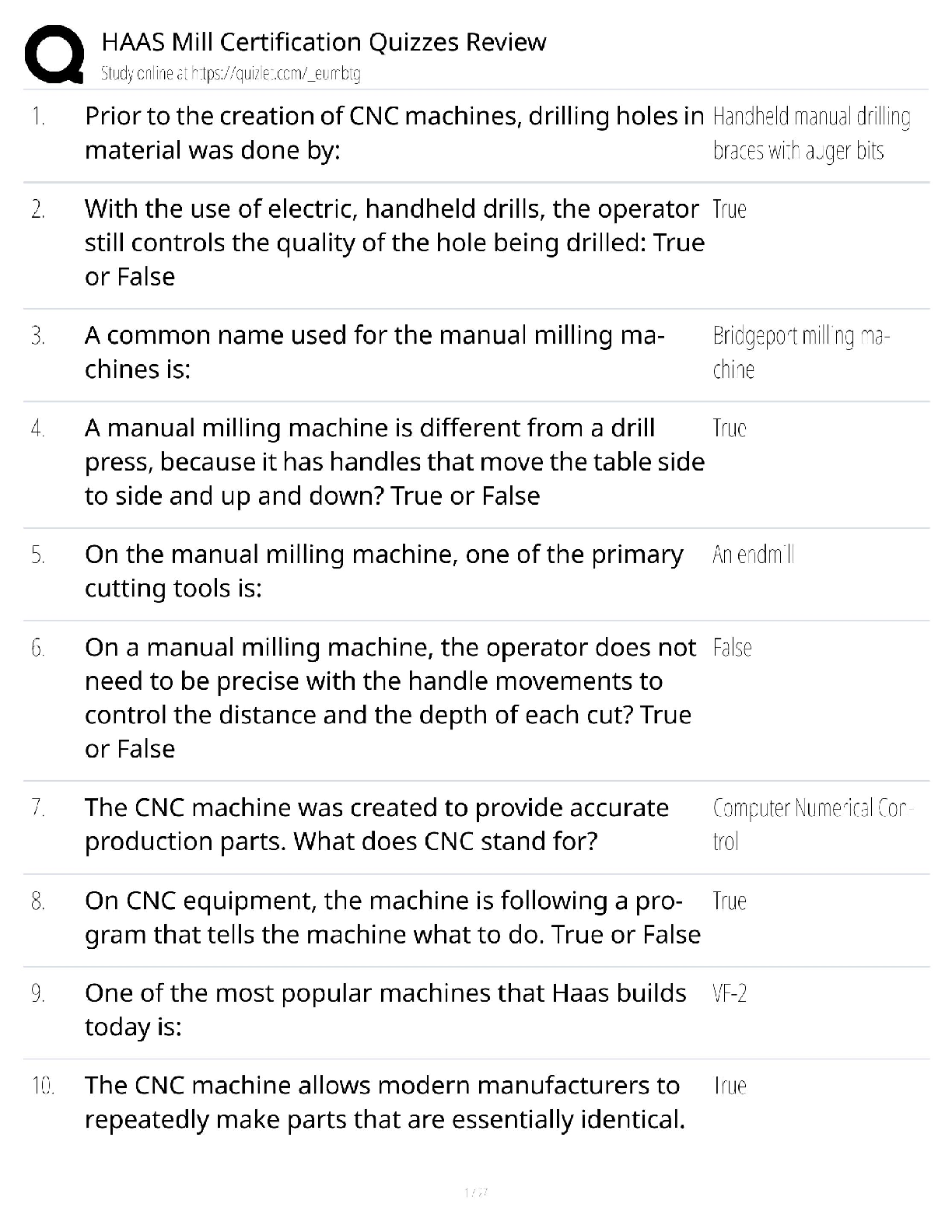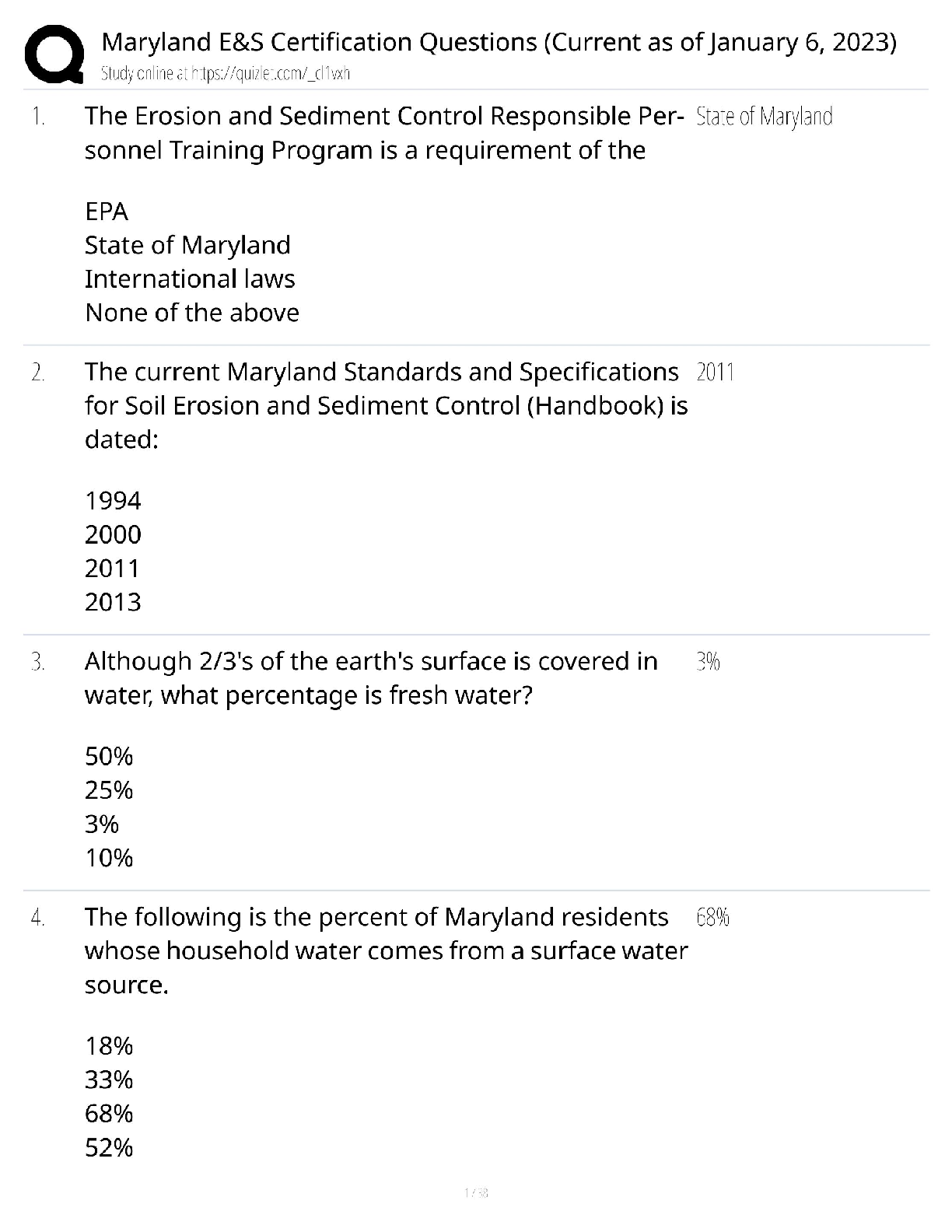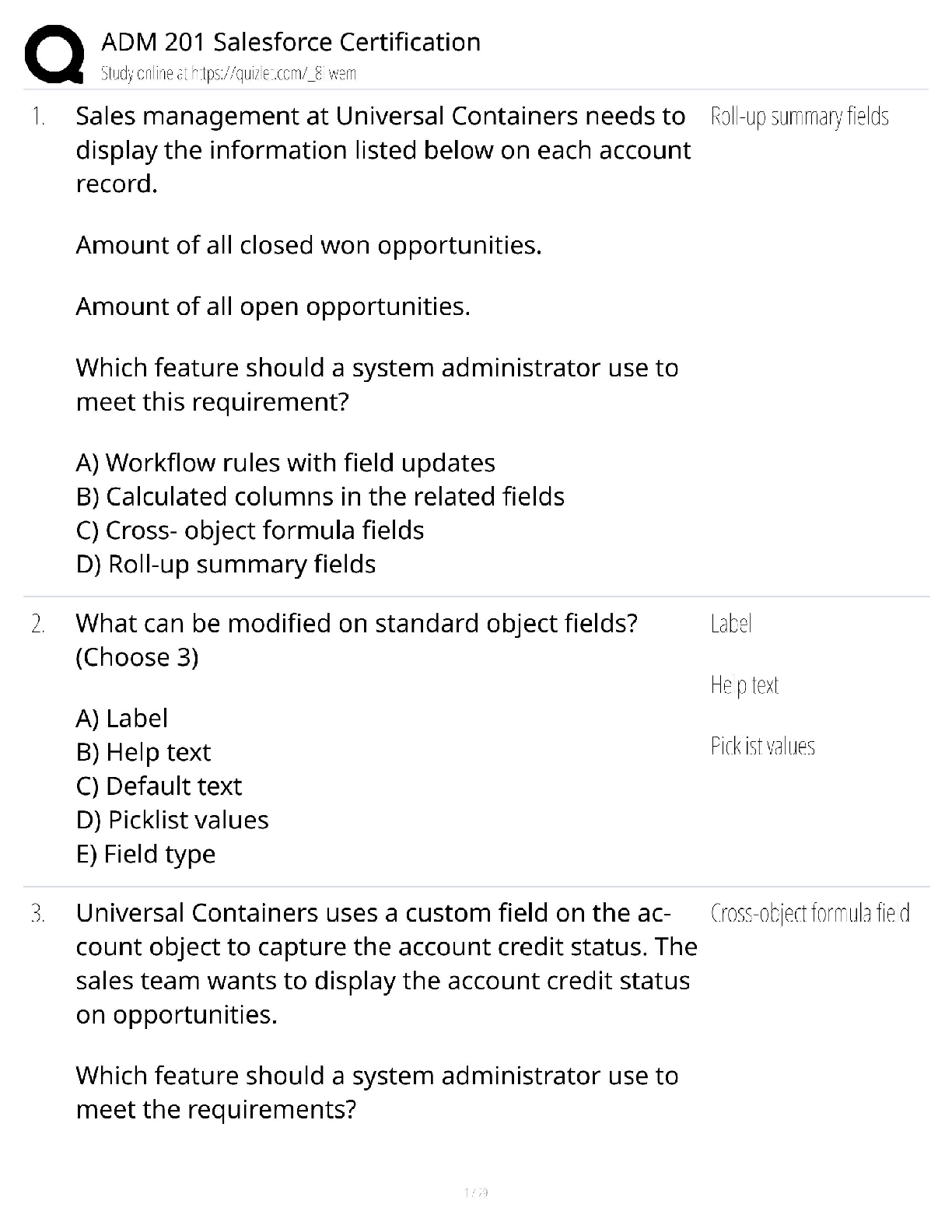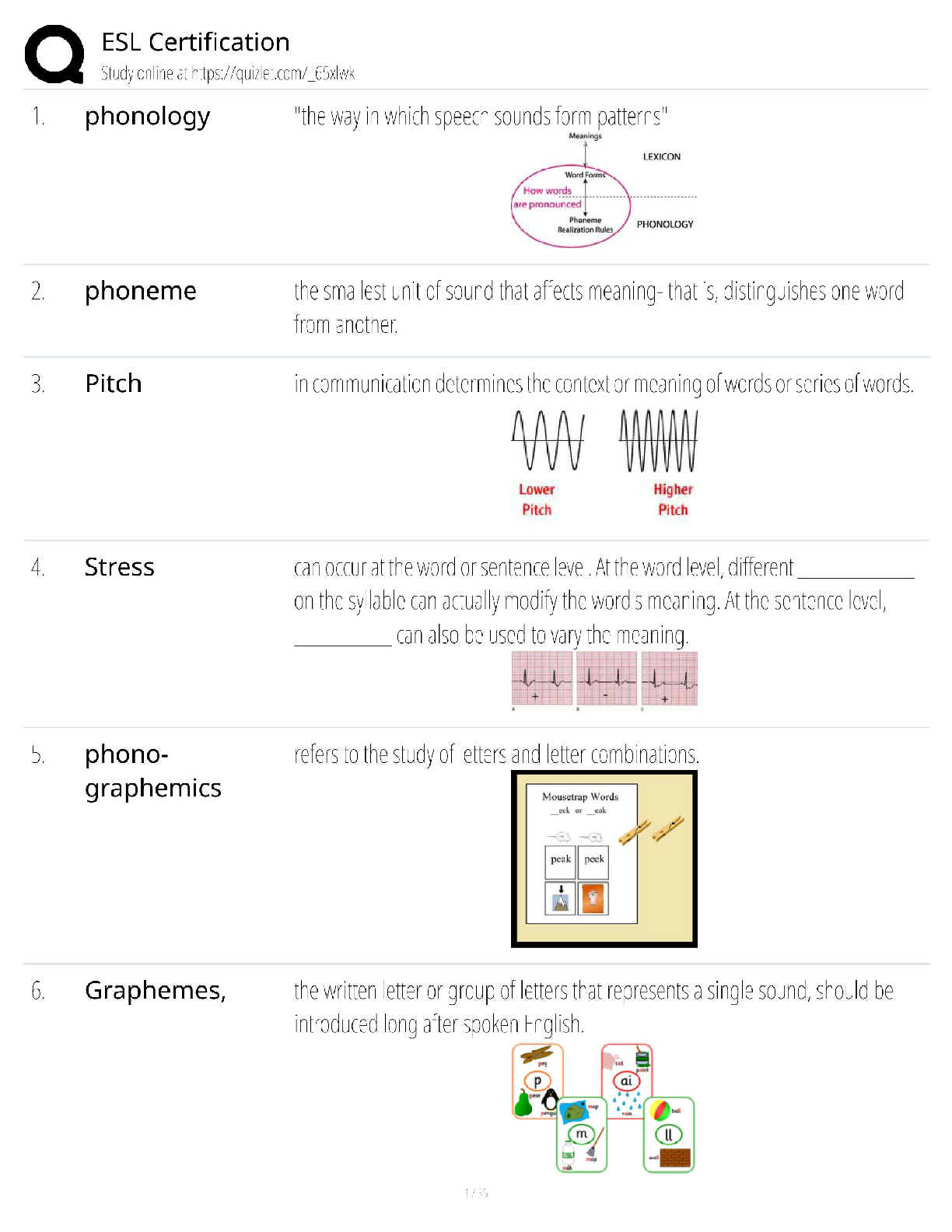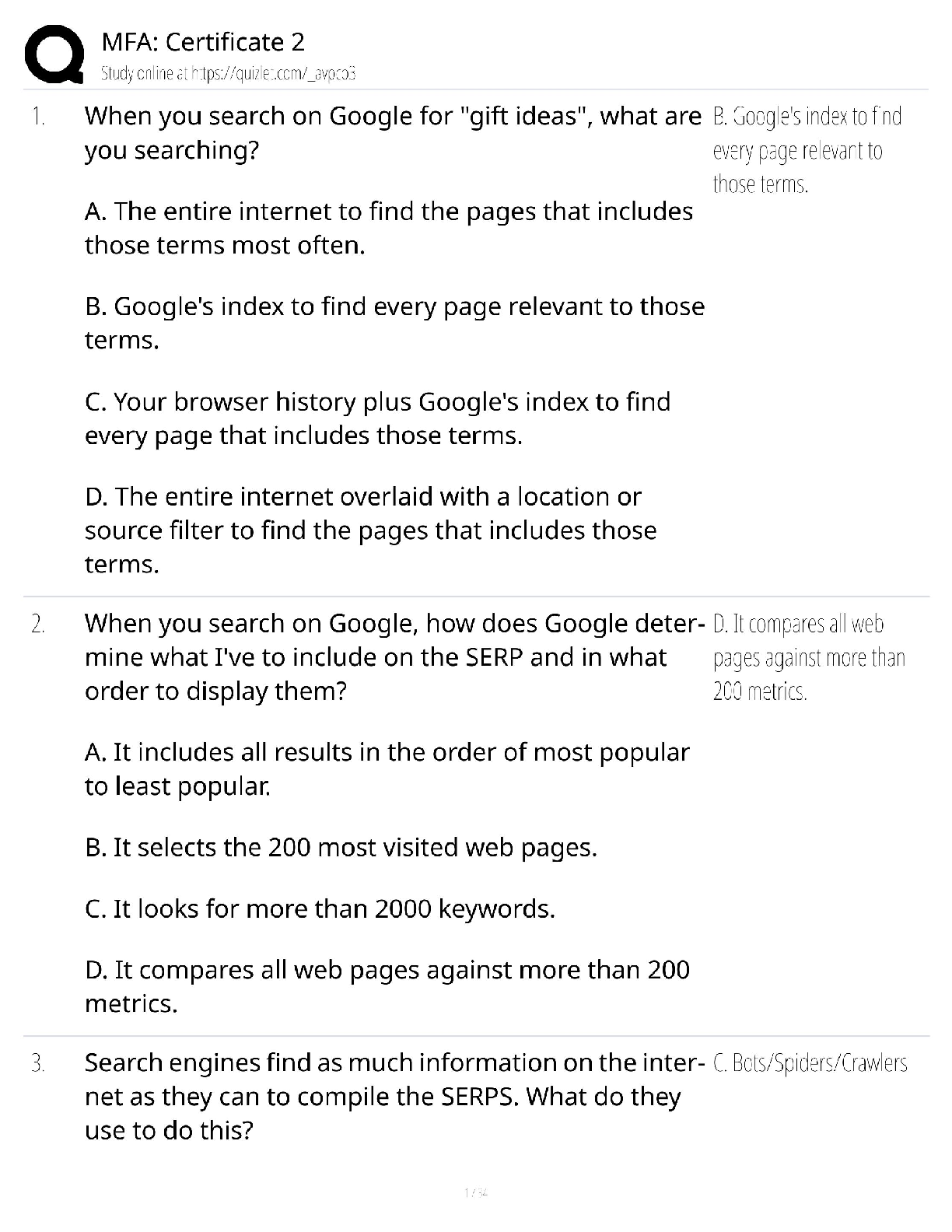Health Care > QUESTIONS & ANSWERS > NUR152 Exam 2. Review Questions and answers. Predictor Questions. 100% approved pass rate (All)
NUR152 Exam 2. Review Questions and answers. Predictor Questions. 100% approved pass rate
Document Content and Description Below
List Maslow's hierarchy of needs from the top of the pyramid to the bottom. - Ans-Self-actualization Self-esteem Love and belonging Safety and security Physiological needs List the components o ... f the nursing process in the correct order. - Ans-Assessment Diagnosis Planning outcomes Planning interventions Implementation Evaluation What is assessment? - Ans-Systematic gathering of information related to the physical, mental, spiritual, socioeconomic, and cultural status of an individual, group, or community. What are some of the features of an assessment? - Ans-Collecting data Using a systematic and ongoing process Categorizing data Recording data What is subjective data? - Ans-(symptoms) Information perceived only by the affected person What the person says What is objective data? - Ans-(signs) Observable and measurable data Can be seen, heard, or felt by someone other than the person experiencing the S/Sx (signs & symptoms) When should a nurse validate data? - Ans-Subjective/objective data do not agree or make sense Client's statements differ at different times in the interview Data are far outside normal range Factors are present that interfere with accurate measurement How is assessment related to diagnosis? - Ans-Data are used to identify the client's actual or potential health problems and strengths. How is assessment related to planning outcomes and interventions? - Ans-Data help you formulate realistic goals and choose interventions most likely to be acceptable to and effective for the client. How is assessment related to implementation? - Ans-You gather data by observing the client's responses as you perform interventions. How is assessment related to evaluation? - Ans-You assess client responses to interventions; client responses are data. What are some ways to prepare to interview (assess) a client? - Ans-Know the purpose of the interview and how the data will be used Read the client's chart Form some goals and opening questions Schedule uninterrupted time Have your forms and equipment Compose yourself before entering the room Provide privacy & remove distractions How should a nurse prepare a client for assessment? - Ans-Introduce yourself Call the client by name Tell the client what you will be doing and why Assess readiness to discuss health issues Assess and provide for comfort Assess for anxiety What are some guidelines to follow while assessing? - Ans-Individualize your approach Use active listening Pay attention to nonverbal communication Use mostly open-ended questions Avoid health-care jargon Curb your curiosity Do not give advice or voice approval/disapproval What are some things to think about and/or do after the assessment? - Ans-Is my data complete, accurate, validated? Did I record data, not conclusions? Did I follow up with special needs assessment if indicated? Think about the client interview Review the physical assessment, observation, and examination What is the difference between medical diagnoses and nursing assessments? - Ans-Medical assessments : Focus on disease and pathology (only medical doctors can perform) Nursing assessments : Focus on the client's responses to illness What is the purpose of nursing diagnosis? - Ans-Identify: How the patient responds to actual or potential health and life processes Factors that contribute to, or cause, health problems (etiologies) Resources or strengths upon which the patient can draw to prevent or resolve problems What is a medical diagnosis? - Ans-Medical Diagnosis: Describes a disease, illness, or injury for which the physician directs the primary treatment. (only medical doctors may make medical diagnoses) What is a nursing diagnosis? - Ans-Nursing Diagnosis: A statement of client health status that nurses can identify, prevent, or treat independently What are a few examples of medical diagnoses? - Ans-Right hip fracture Cellulitis COPD What are a few examples of nursing diagnoses? - Ans-Acute pain Impaired mobility Impaired skin integrity Impaired gas exchange Social isolation What are the three components of an "actual" nursing diagnosis? - Ans-Problem Etiology Defining characteristics Describe the 'problem' component of the nursing diagnosis. - Ans-Describes health state or health problem of the patient Describe the 'etiology' component of the nursing diagnosis. - Ans-Identifies factors believed to cause or contribute to the problem Describe the 'defining characteristics' component of the nursing diagnosis. - Ans-The subjective and objective data that signal the existence of a problem Identify the problem, etiology, and defining characteristics of this assessment data: Strong body and urine odor, unclean hair, pt stating "I'm afraid I'll fall in the tub and break something" - Ans-Problem: Bathing/hygiene self-care deficit Etiologt: Fear of falling Defining characteristics: strong body and urine odor, unclean hair, pt stating their fear of falling and fractures What are some of the ways to analyze assessment data? - Ans-Identify significant data Cluster cues Identify data gaps and inconsistencies Draw conclusions about health status Make inferences Identify problem etiologies Verify problems with the patient How do you go about choosing a NANDA label? - Ans-Use a nursing diagnosis handbook, compare definitions and defining characteristics of the diagnostic labels with your cue cluster Identify a possible cause for each of the following NANDA diagnoses: 1. Impaired physical mobility 2. Dressing self-care deficit 3. Ineffective breathing pattern - Ans-1. hip fracture 2. CVA 3. COPD What does ABC mean? - Ans-Airway Breathing Circulation What criteria should you keep in mind when prioritizing patient's problems? - Ans-ABCs Maslow's Hierarchy of Needs What are the goals of the planning phase of the nursing process? - Ans-Establish priorities Identify and write expected patient outcomes Select evidence-based nursing interventions Communicate the plan of care Come up with an outcome for each of the following nursing diagnoses: 1. Risk for infection r/t malnutrition 2. Pain (chest) r/t imbalance of myocardial oxygen supply and demand - Ans-1. The client will show no signs or symptoms of infection this shift 2. Pt will verbalize relief of chest pain by the end of this shift What is ongoing planning? - Ans-Changes made to initial plan as pt's response to care is evaluated Critical thinking and the nursing process have which of the following in common? Both: 1) Are important to use in nursing practice 2) Use an ordered series of steps 3) Are patient-specific processes 4) Were developed specifically for nursing - Ans-1) Are important to use in nursing practice In which step of the nursing process does the nurse analyze data and identify client problems? 1) Assessment 2) Diagnosis 3) Planning outcomes 4) Evaluation - Ans-2) Diagnosis In which phase of the nursing process does the nurse decide whether her actions have successfully treated the client's health problem? - Ans-Evaluation What is the most basic reason that self-knowledge is important for nurses? Because it helps the nurse to: 1) Identify personal biases that may affect his thinking and actions 2) Identify the most effective interventions for a patient 3) Communicate more efficiently with colleagues, patients, and families 4) Learn and remember new procedures and techniques - Ans-1) Identify personal biases that may affect his thinking and actions Arrange the steps of the nursing process in the sequence in which they generally occur. A. Assessment B. Evaluation C. Planning outcomes D. Planning interventions E. Diagnosis 1) E, B, A, D, C 2) A, B, C, D, E 3) A, E, C, D, B 4) D, A, B, E, C - Ans-3) A, E, C, D, B How are critical-thinking skills and critical-thinking attitudes similar? Both are: 1) Influences on the nurse's problem-solving and decision making 2) Like feelings rather than cognitive activities 3) Cognitive activities rather than feelings 4) Applicable in all aspects of a person's life - Ans-1) Influences on the nurse's problem-solving and decision making The nurse is preparing to admit a patient from the emergency department. The patient has chronic lung disease and has used tobacco for 30+ years. The nurse used to smoke a pack of cigarettes a day and worked very hard to quit smoking. She thinks to herself, "I know I tend to disapprove of people who use tobacco, especially when they have a serious lung condition; I figure if I can stop smoking, they should be able to. I must remember how difficult that is, and be very careful not to let be judgmental of this patient." This best illustrates: 1) Theoretical knowledge 2) Self-knowledge 3) Using reliable resources 4) Use of the nursing process - Ans-2) Self-knowledge A clinic client has not been keeping his scheduled follow-up appointments. In talking with him about that, the nurse asks, "Do you have a car or other transportation to bring you to the clinic?" Which critical-thinking process does that question illustrate? 1) Inquiry based on credible sources 2) Reflective skepticism 3) Analyzing assumptions 4) Contextual awareness - Ans-4) Contextual awareness [Show More]
Last updated: 3 years ago
Preview 1 out of 86 pages

Buy this document to get the full access instantly
Instant Download Access after purchase
Buy NowInstant download
We Accept:

Reviews( 0 )
$10.00
Can't find what you want? Try our AI powered Search
Document information
Connected school, study & course
About the document
Uploaded On
Jun 05, 2022
Number of pages
86
Written in
All
Seller

Reviews Received
Additional information
This document has been written for:
Uploaded
Jun 05, 2022
Downloads
0
Views
86













